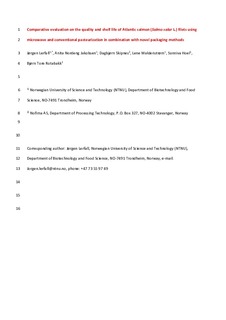Comparative evaluation on the quality and shelf life of Atlantic salmon (Salmo salar L.) filets using microwave and conventional pasteurization in combination with novel packaging methods
Lerfall, Jørgen; Jakobsen, Anita Nordeng; Skipnes, Dagbjørn; Waldenstrøm, Lene; Hoel, Sunniva; Rotabakk, Bjørn Tore
Journal article, Peer reviewed
Accepted version
Permanent lenke
http://hdl.handle.net/11250/2579072Utgivelsesdato
2018Metadata
Vis full innførselSamlinger
Sammendrag
A comparative evaluation on the effect of carbon dioxide (CO2) on quality and shelf life of Atlantic salmon loins pasteurized with microwave and conventional technology was conducted. The experimental design allowed CO2 to enter the salmon muscle before (soluble gas stabilization [SGS] + vacuum) or after pasteurization (CO2 emitter + vacuum), whereas the control samples (vacuum only) were not presented for CO2. This setup resulted in six different groups; three heated with microwaves and three with conventional pasteurization. The core temperature of microwave samples was 58.8 ± 2.2 °C, whereas the surface temperature was equal to the oven temperature (62 °C) during conventional pasteurization and close to the core temperature during microwave pasteurization (57.6 ± 1.4 °C). Microwave‐heated samples showed higher microbial growth; decreased shelf life; and darker (lower L*‐value), more reddish (higher a*‐value), and yellowish (higher b*‐value) colors compared to conventional‐heated salmon. Lowest liquid loss (LL) was observed in salmon packaged with the CO2 emitter, whereas a SGS step prior to pasteurization did not affect the LL negatively as compared to samples packaged in vacuum only. Treatment with CO2, independent of the prestep using SGS or an emitter, resulted in increased shelf life. Protein denaturation, microbial growth, product color, product shelf life, and sensory properties of the salmon loin were significantly affected by the applied pasteurization method (microwave‐ or conventional pasteurization). However, the heat load was probably too high to detect differences resulting from the pretreatment using SGS or packaging with CO2 emitter.
